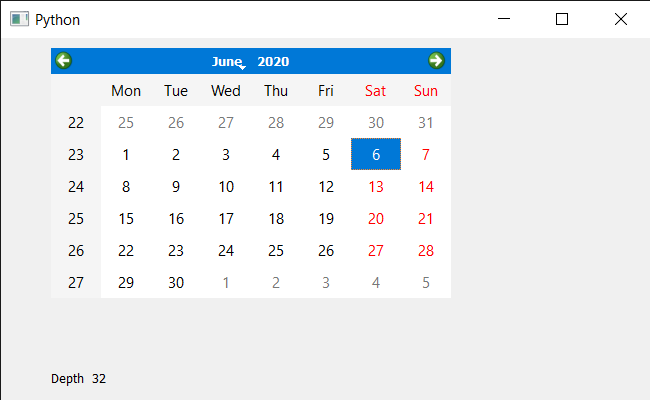En este artículo veremos cómo podemos obtener profundidad del QCalendarWidget. La profundidad de color o profundidad de color, también conocida como profundidad de bits, es la cantidad de bits que se usan para indicar el color de un solo píxel, en este calendario, o la cantidad de bits que se usan para cada componente de color de un solo píxel.
Para hacer esto, usaremos
depthel método con el objeto QCalendarWidget.Sintaxis: calendario.profundidad()
Argumento: no requiere argumento
Retorno: Devuelve entero
A continuación se muestra la implementación.
Python3
# importing libraries
from PyQt5.QtWidgets import *
from PyQt5 import QtCore, QtGui
from PyQt5.QtGui import *
from PyQt5.QtCore import *
import sys
class Window(QMainWindow):
def __init__(self):
super().__init__()
# setting title
self.setWindowTitle("Python ")
# setting geometry
self.setGeometry(100, 100, 650, 400)
# calling method
self.UiComponents()
# showing all the widgets
self.show()
# method for components
def UiComponents(self):
# creating a QCalendarWidget object
self.calendar = QCalendarWidget(self)
# setting geometry to the calendar
self.calendar.setGeometry(50, 10, 400, 250)
# setting cursor
self.calendar.setCursor(Qt.PointingHandCursor)
# creating a label
label = QLabel(self)
# setting geometry
label.setGeometry(50, 280, 420, 120)
# making it multi line
label.setWordWrap(True)
# getting depth
value = self.calendar.depth()
# setting text to the label
label.setText("Depth " + str(value))
# create pyqt5 app
App = QApplication(sys.argv)
# create the instance of our Window
window = Window()
# start the app
sys.exit(App.exec())
Producción :
Publicación traducida automáticamente
Artículo escrito por rakshitarora y traducido por Barcelona Geeks. The original can be accessed here. Licence: CCBY-SA